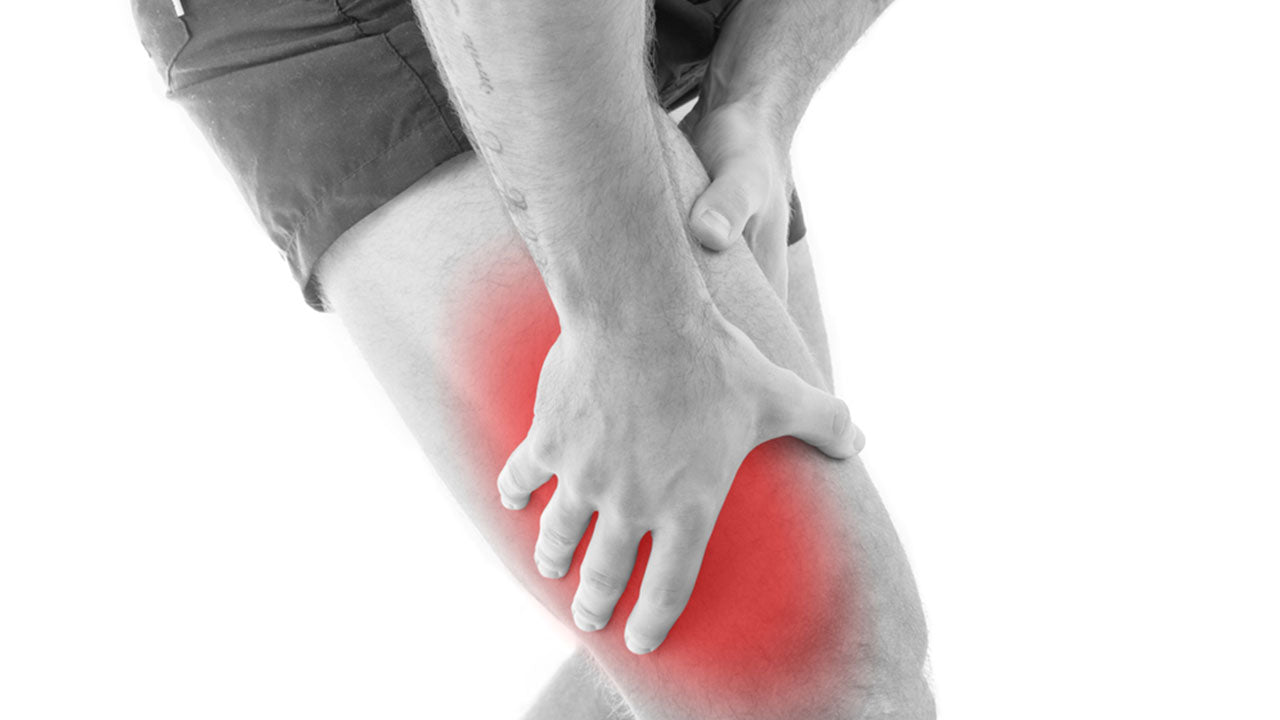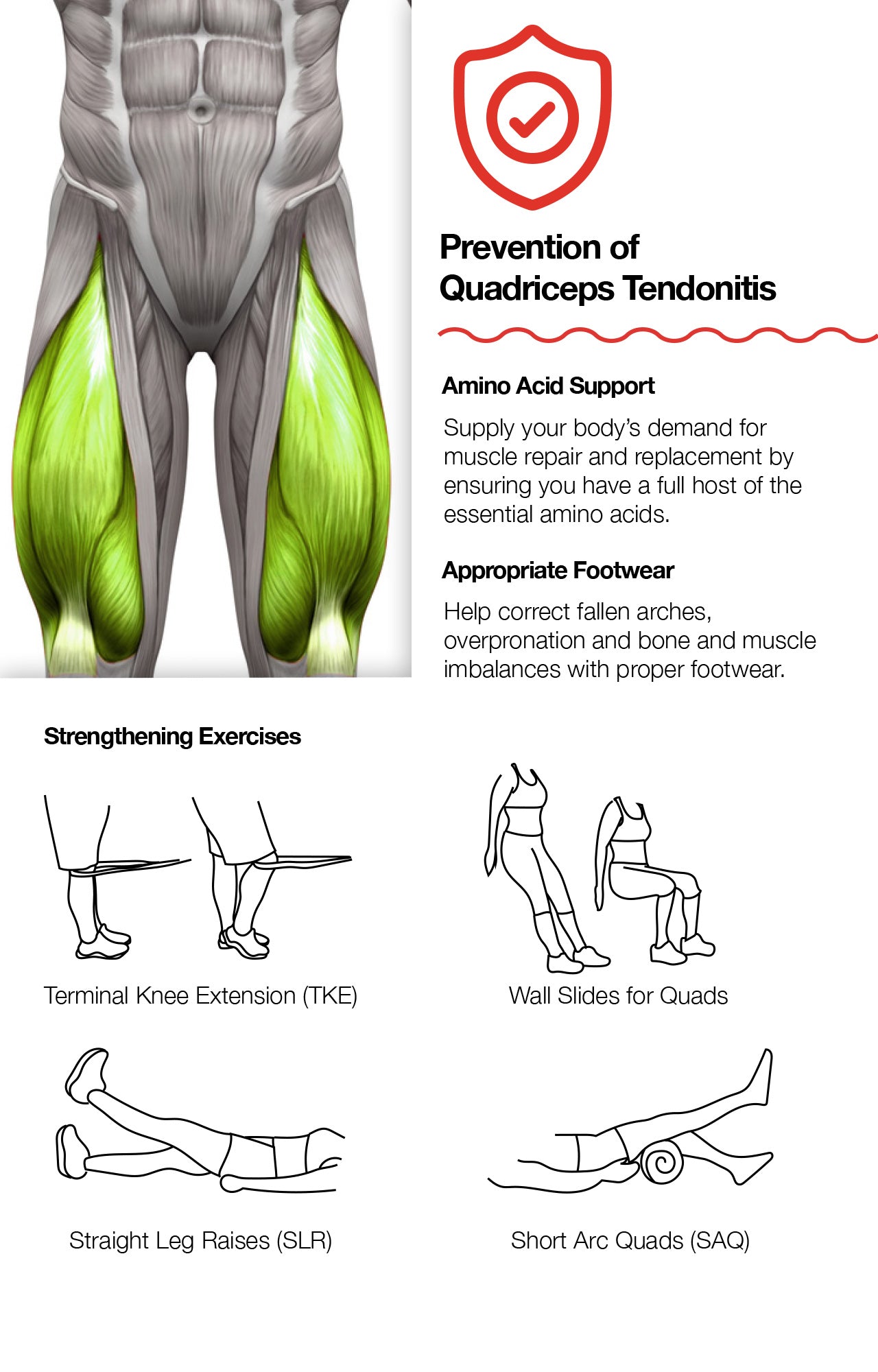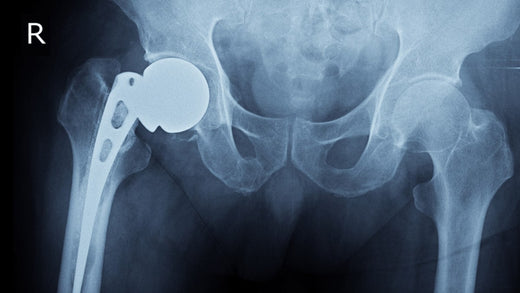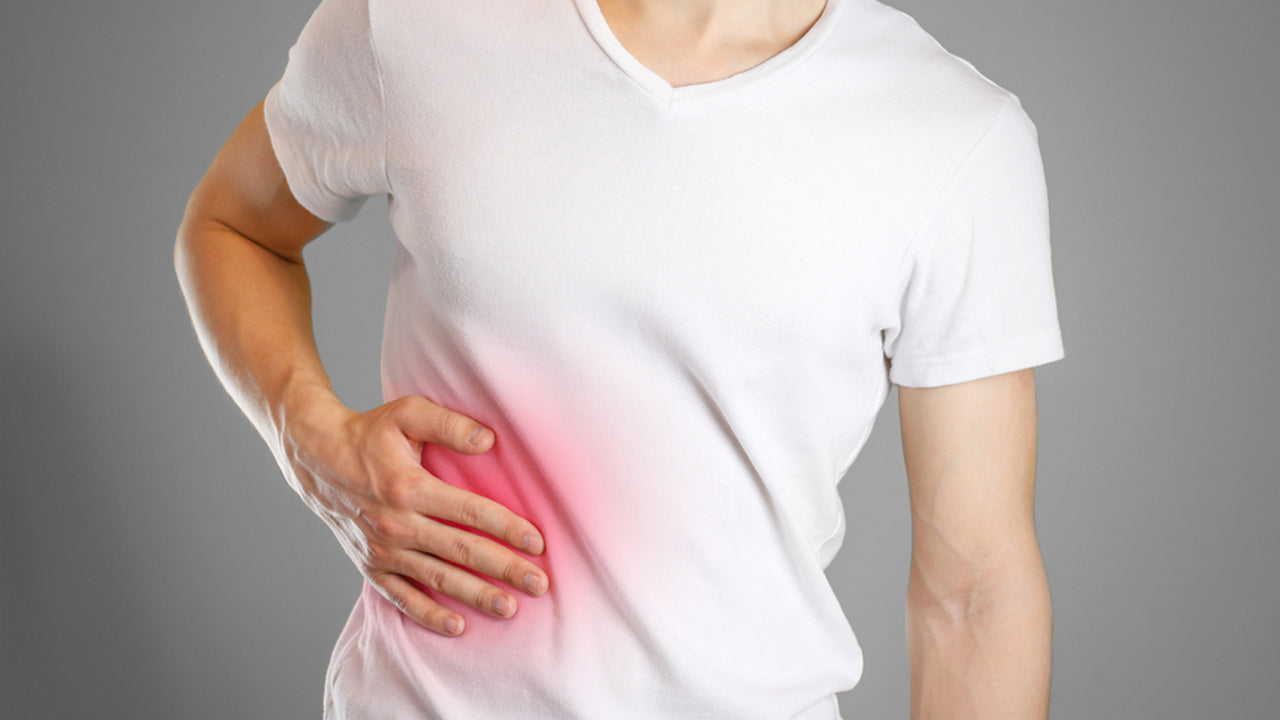Quadriceps Tendonitis: Symptoms, Stretches and Strengthening Solutions
 By: by Amino Science
By: by Amino Science

Quadriceps tendonitis (sometimes spelled tendinitis) afflicts the area just above the knee where the quadriceps muscles and tendons are located. Untreated tendonitis in this area could escalate to tendinosis (the long-term chronic form of tendonitis) and eventually require knee surgery. Find out what causes this damage, the signs and symptoms of quadriceps tendonitis, and how to stretch and strengthen the muscles, ligaments, and tendons of the knee joint.
Anatomy of the Knee
The knee joint is the meeting place of the tibia (shinbone) and the femur (thighbone) behind the patella (kneecap). The kneecap is enveloped by a tendon that connects the quadriceps muscles (on the front of the thigh) to the shinbone at a spot known as the tibial tubercle just below the kneecap.
The quadriceps tendon on top of the kneecap and the patellar tendon on the underside of it make up what is known as the quadriceps mechanism. Patellar tendonitis (jumper's knee) is sometimes mistaken for quadriceps tendonitis due to the close working relationship within the soft tissues of the knee joint. Correctly identifying the cause and source of your knee pain is the first step to fixing it.

Symptoms and Causes of Quadriceps Tendonitis
The quadriceps are essential for jumping, walking, running, climbing, and squatting. Overuse by athletes, sports players, and runners can cause painful inflammation and long-lasting harm, but there are ways to help avoid quadriceps pain and injury (read to the end of the article for those details). Tendonitis can afflict the connective tissue of the wrist, foot, elbow, and more, but here's how it presents in the knee.
Signs and Symptoms of Quadriceps Tendonitis
It's important to recognize and identify the cause of knee pain related to the large muscles of the thigh and the patella tendons. Tendonitis in general causes a feeling of burning, itching inflammation, and quadriceps tendonitis pain is located at the base of the thigh, just above the knee. The pain is most noticeable during knee movement, and may also present with other symptoms like:
- Touch sensitivity and tenderness
- Stiffness and aching after inactivity (sleeping, sitting)
- Swelling of the knee joint
- Weakness and limited mobility
- Worsening pain and burning after use or during a workout
Common Causes and Risk Factors for Quadriceps Tendonitis
Here's a breakdown of the risk factors and causes of quadriceps pain.
- Advancing age: Aging affects the entire body, and often joint pain is one of the earliest signs that natural wear and tear or overuse is taking its toll on older athletes.
- Certain sports activities: Sporting activities that include running and jumping like volleyball, soccer, basketball, and sprinting can quickly lead to knee injuries like ACL tears, MCL damage, and tendonitis.
- Misalignment or poor movement: If your foot, knee joint, or spine is inherently misaligned or your gait or posture is incorrect, you may be experiencing quadriceps pain. A condition such as overpronation as you walk could be causing the pain you're experiencing further up the leg.
- Certain professions: Working in construction, emergency medicine, or in a warehouse situation involves a great deal of squatting, kneeling, and lifting, all of which could cause quadriceps knee pain and tendonitis.
- Exercise issues: Not stretching before exercise, returning to exercise too soon before healing, or working out on hard surfaces could injure the quadriceps tendon.
- Trauma: A direct impact to the area from an accident, fall, or sports collision could lead to quadriceps pain and inflammation.
- Surrounding or underlying issues: Excessive body weight adds extra stress to your joints and the tendons and ligaments within them. Other surrounding muscles like your hamstrings may be too tight, or chronic diseases like arthritis, lupus, or diabetes could be hampering the blood supply or functionality of the knee enough to cause tendonitis.

Diagnosis and Treatment of Quadriceps Tendonitis
Depending on the severity of your knee's condition, treatment may vary after diagnosis.
Diagnosis
A doctor or physical therapist is likely to confirm your knee problem using the following diagnostics.
- Physical exam: A manual examination of your lower extremities can help a professional pinpoint the origin of your pain.
- Medical history: Assessing changes in behavior can help your doctor determine the source of your current pain (examples include a sudden increase in physical activity or an injury that is not healing properly).
- X-rays: Though they can't show soft tissue injuries, X-rays can confirm whether or not your pain is caused by issues with bone alignment.
- MRIs: Used for identifying soft tissue causes, an MRI (magnetic resonance imaging) can reveal whether or not there is a tendon tear.
Treatment
Once the cause of quadriceps tendonitis is established, the next step is treatment, which may include some combination of the following treatment options.
- RICE: Nonsurgical treatments like RICE (Rest, Ice, Compression, Elevation) may be all your body needs to heal itself. Supplements containing the essential amino acids necessary for tissue repair can speed up the healing process.
- Physical therapy: Massage, heat and cold treatments, and therapies such as ultrasound or electrical stimulation may help your healing. Consult a professional to determine the best ways to exercise going forward.
- Knee braces and orthotics: Taping your knees, using a splint, or purchasing a neoprene knee sleeve can help stabilize your knee as you heal and prevent damaging movements or slips. Likewise, an orthotic insert in your shoes can help correct your gait, reduce the stress on your knee, or correct a physical imbalance like one leg being shorter than the other (a common cause for knee and back pain).
- Over-the-counter anti-inflammatory medications: NSAIDs (nonsteroidal anti-inflammatory drugs) like aspirin, naproxen, or ibuprofen can help reduce pain, inflammation, and swelling while you heal, as can natural anti-inflammatories like turmeric.
- Surgery: Your doctor may recommend surgery as a last resort in cases of acute quadriceps tendonitis to remove and repair damaged tissue or if the cause of your knee pain requires a surgical solution (like a severely torn or injured tendon). Whether or not surgery is right for you can only be decided in consultation with your physician, and may involve a rehabilitation program to get you back to your former level of activity.

Prevention of Quadriceps Tendonitis
Once you're healed from quadriceps tendonitis and feeling fit, it's important to prioritize activity modification to reduce your risk of experiencing that pain again. Here are some tips for injury prevention.
1. Amino Acid Support
In the early stages of quadricep injury recovery, amino acids are necessary for repairing and replacing soft tissue like muscle. Once you have regained your full range of motion, continued use of an essential amino acid supplement helps prevent overuse injuries by supplying the body with every building block it needs to fix and regenerate muscle as you work out and play hard.
Too often tendonitis is the result of compounding injury, a little here and a little there until it's too much to heal without ceasing activity for a while. To keep up with the demands you make on your body, be sure it always has a balanced supply of every molecule needed to keep your muscles and collagen fibers in prime condition.
2. Appropriate Footwear
Tendon injuries due to a muscle imbalance caused by inappropriate footwear are some of the most frustrating because they are 100% avoidable. A fallen arch (flat-footedness), overpronation, and underpronation of the foot can be corrected with the right footwear, as can a shortened leg. With the right stability under your feet, you can also avoid improper shinbone rotations, tracking abnormalities of the kneecap, and needless misalignments of the ankles, knees, hips, and back.
3. Strengthening Exercises
Any physical therapist will tell you that warm-up exercises before a workout or sporting activity help prevent a vast number of injuries. Here are a few specific strengthening exercises you can use to target your quads.
Terminal Knee Extension (TKE)
A terminal knee extension is not as ominous as it sounds, but is instead a standing exercise meant to strengthen your quadriceps. Using an exercise band, an immovable object, and your own body weight, the terminal knee extension is done via the following steps.
- Tie the resistance band to something stable and anchored to the wall or floor (a post, heavy exercise machine, or the leg of a sturdy table).
- Step one leg into the band and place the loop just above your slightly bent knee.
- Step back until the band is taught, and straighten your knee slowly against the resistance of the band.
- Hold the tension for 3 seconds before release, and repeat 15 times before switching to the other leg.
Be sure to move through this exercise slowly and steadily, and to always work out both sides of the body evenly to avoid developing a muscle imbalance. This exercise can be ramped up by doing it standing on one foot.
Wall Slides for Quads
Another standing exercise, this one requiring no extra equipment, wall slides for quads benefit your calf, quad, and glute muscles.
- Standing upright with your back to a wall, press your shoulders and lower back until they are flush against the wall. Plant your feet shoulder width apart.
- Bend your knees so that your back slides down the wall until you reach a count of 5 or until your knees are at a 45-degree bent angle. Hold this position for another count of 5.
- Slide back up the wall by straightening your knees again, repeat for 10 total reps.
Remember, when it comes to strengthening slow and steady wins the race. Also be sure not to sink deeper than a 45-degree angle, as sliding up from a squat is much more difficult and could cause an injury. To increase difficulty safely, select a pair of dumbbells to hold while doing this exercise.
Straight Leg Raises (SLR)
This exercise can be done from a floor or any flat surface, like a firm bed for those recovering from surgery.
- Lie down on a flat surface and bend one knee up to a 90-degree angle.
- Keep the other leg straight and raise it until your thighs are parallel.
- Hold for 5 seconds before lowering the leg back down slowly. Repeat up to 15 times before switching to the other leg.
A weighted cuff can increase the difficulty of this exercise, as can using a resistance band placed around both ankles.
Short Arc Quads (SAQ)
This exercise is also done in a lying down or sitting position.
- Lie down on a flat surface and use a foam roller, basket or medicine ball, or a paper towel roll to prop up one knee.
- Slowly extend the propped leg until the knee is straight, and hold for 5 seconds.
- Lower the leg back down, and repeat up to 15 times before switching to the other leg.
When the knee is in the straightened position, try to tense your quadricep specifically during the 5-second hold. Utilize a weighted cuff to make the exercise more challenging.


Up to 25% off Amino
Shop NowTAGS: exercise
Join the Community
Comments (0)
Most Craveable Recipes




 833-264-6620
833-264-6620



















